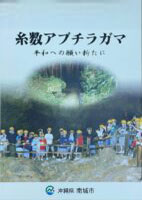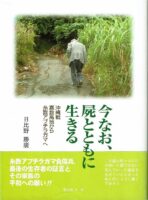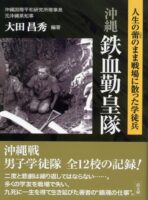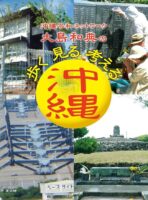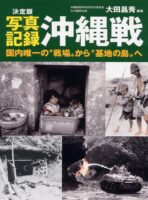Overview of the Battles centered on the Itokazu Abuchiragama Cave
| Year | Month Day | Event |
| 1944 | Around July |
Units in the Japanese army are stationed in Tamagusuku Village creating a strong military presence. The headquarters of the 1st battalion (Také unit) of the 19th regiment of the 9th division is positioned in Tamagusuku Elementary School. The 9th division (Také unit) enters the Abuchiragama Cave and starts preparations. |
| October 10th |
Major air raid on Naha. |
|
| Around late November |
Due to military disposition, the headquarters of the 15th independent infantry battalion of the Ishi unit is positioned in Tamagusuku elementary school. |
|
| 1945 | December 27th |
The powerful Také unit is transferred to Taiwan. |
| February 1st |
The headquarters of the 15th independent mixed regiment (Colonel Mita) is relocated to Tamagusuku elementary school. The Mita regiment of the Tama unit moves from Tamagusuku elementary school to a billet in Itokazu. Power lines are installed to illuminate the cave using a generator from a sugar refining factory. An air hole with a diameter of 1m is established in the cave. |
|
| Around March 20th |
The Mita regiment enters the combat information center cave on the south side of the Itokazu Castle Ruins. |
|
| March 23rd |
Bombardment by warships from off the coast of Minatogawa starts. |
|
| March 24th |
The village people evacuate to an allocated refuge cave. The bombardment off the coast of Minatogawa continues. Around 200 local residents of Itokazu evacuate to the Itokazu Abuchiragama Cave. |
|
| April 1st |
The American army lands on the west coast in the central part of the main island of Okinawa. |
|
| Early April |
The sea raiding base of the 28th battalion is transferred from the Shikenbaru base to the Abuchiragama Cave. A great amount of food for the army is gathered in the cave which has a generator. |
|
| April 27th |
The Mita regiment is transferred to the Shuri battle line. The defense forces from the sea raiding base of the 28th battalion leave the Abuchiragama Cave. |
|
| April 28th |
Military doctor Oshiro from the Haebaru Army Hospital is transferred to the Itokazu Abuchiragama Cave to be the head doctor. A medical system is established as the Itokazu medical center. |
|
| May 1st |
14 members of the Himeyuri student corps lead by Teacher Chizen Oshiro arrive at the Abuchiragama Cave before daybreak from the Haebaru Army Hospital. Many seriously injured patients come and are taken care of on this day. From May 2nd on, this medical center shoulders patient after patient with serious injuries. |
|
| Around May 10th |
The army doctor Lieutenant Nishihira comes to the Abuchiragama Cave with a second lieutenant who is a pharmacist and 8-9 other soldiers to provide medical support. |
|
| Around May 12th |
Army doctor Yafuso, his family, and 2 members of the Himeyuri student corps come to the Cave to provide support. |
|
| Around mid-May |
Injuries to seriously injured patients worsen in the cave infesting it with pus and maggots. The number of patients with encephalosis and tetanus increases. |
|
| May 25th |
Upon evacuation orders, seriously injured patients and the Himeyuri student corps are transferred from the Abuchiragama Cave to the Southern Ihara Itokazu Cave (First Surgical Cave). A hundred and several tens of patients who cannot walk and 4 soldiers who are monitoring provisions remain. |
|
| May 26th- May 30th |
The seriously injured patients who remained leave one after another with some evacuating south. |
|
| Around late May |
The American army enters Tamagusuku Village. The American army builds a barracks in Hyakuna inside the village. |
|
| June 1st |
Some refugees from the village are taken in by the American army and moved to the Hyakuna refugee camp in Tamagusuku Village. |
|
| June 6th |
The Itokazu Abuchiragama Cave is attacked by the American army. 2 members of the American army enter the cave but warning shots are given so they retreat. |
|
| June 8th |
White phosphorus cartridges are thrown into the current exit causing people to suffer burn injuries. |
|
| Around June 10th |
20 drums filled with gasoline are thrown into the entrance and air hole but luckily these are not ignited. The local residents and seriously injured patients suffer from the smell of the gasoline and some of these people die due to this. |
|
| June 13th- June 14th |
The American army places an artillery gun at the current exit with the intention of firing it. However, the artillery gun shifts downward and is not able to hit its target. The American army cover up the current exit with soil. |
|
| June 17th |
A point blank explosion in the Ihara Itokazu medical center which was transferred from the Itokazu Abuchiragama Cave kills a great number of students and soldiers. |
|
| June 23rd |
The war ends in Okinawa. |
|
| August 15th |
Japan surrenders unconditionally. |
|
| August 22nd |
Refugees in the Itokazu Abuchiragama Cave come out and are taken in by the American army. 7 seriously injured soldiers and refugees still remaining in the cave come out together and are taken in by the American army. |
|
| Around mid-September |
The final 3 people including 1 soldier and 2 local residents who had barricaded themselves in the cave are taken in by the American army. |
|
| Around 1948 |
The remains of people are recovered in the village and gathered at a memorial monument at the exit of the Abuchiragama Cave. Full-scale recovery of the remains of people in the Abuchiragama Cave is carried out. |
|
| Around 1957 |
The remains of people from Abuchiragama Cave are put into kamasu straw bags and carried to the Konpaku-no-to (Column of Spirits). |
|
| 1994 |
The Abuchiragama Preservation Committee is established. |





